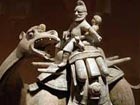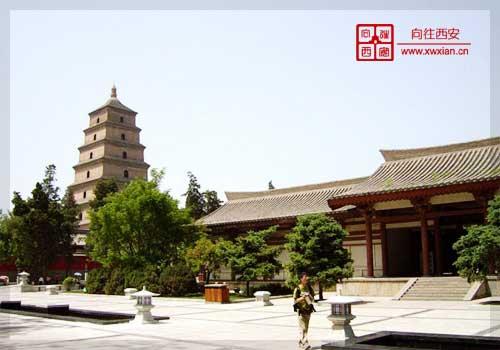| Videos | • Latest |
|
• Feature | • Sports | • Your Videos |
Tang Dynasty Arts Museum

Throughout China's ancient history, perhaps one of the most prosperous, and culturally flourishing periods was the Tang Dynasty, from the 7th to the 10th centuries. We can get a glimpse of that beautiful period through books and artifacts, but today, we're going to see the Tang come to life at the Tang Dynasty Arts Museum in Xi'an.
 |
|
The Tang Dynasty Arts Museum,founded in 1988, was the first museum focused on one particular dynasty in China. |
The Tang Dynasty Arts Museum,founded in 1988, was the first museum focused on one particular dynasty in China. Now the museum has moved into its new home, the "Tang Paradise", a reconstructed imperial garden of the Tang Dynasty, just south of the ancient Big Wild Goose Pagoda. The pagoda, built some 14 centuries ago, was built for the famous Monk, Xuanzang, to translate the Buddhism scripts he had attained after 17 years overland journey to India.
Standing at the center of the tourism site is a model depicting a panorama of Tang Dynasty, the peak of China's more than two thousand years of society.
Zhang Baishun, director of Tang Dynasty Arts Museum, said, "Tang Dynasty Arts Museum is China's first museum built in an imperial garden. "Tang Paradise" is the biggest imperial garden reconstructed in China. With an investment of 1.3 billion yuan, the garden covers nearly 700 thousand square meters and about one third is water. The museum is part of the complex and gives visitors a close and complete look at the Tang Dynasty from architecture and sculpture to painting and music. Here, we can see various precious relics of the period and also some interactive events."
Founded in the early 7th century, the Tang dynasty is the golden age of progress and stability. The strong economic background had brought with it, prosperity of culture and art. The period is known for its free, open and diverse spirit and style. Contrary to today's pursuit for slimness, women in the Tang Dynasty were appreciated for their plumpness.
The ancient capital Chang'an or today's Xi'an was a melting pot of abundant cultures brought and created by people from around the world. Some of the most symbolic relics unearthed under the ground of the ancient metropolis are displayed at the museum, providing a clue for today's visitors to about China's past glory.
Mao Yaqin, interpreter of Tang Dynasty Arts Museum, said, "These are all the mirrors dating back to the Tang Dynasty. They were not ordinary mirrors. For instance, this one belonged to the Emperor Xuanzong. It's a birthday gift presented to him from his minister. You can see, on the back of the mirror, there is a dragon carved around the center. The dragon was exclusive used for Chinese emperors in the ancient times. And there are two Chinese characters "Qian" and "Qiu" carved on each edge on the left and right. Together the word means longevity. At the birthday party, Emperor Xuanzong also gave some special bronze mirrors to his ministers. "
Emperor Zuanzong is the seventh emperor of the Tang and had the longest reigning period of the Dynasty, 43 years. He is the man who brought Tang China to its pinnacle of culture and the one who also experienced the decline from the Anshi Rebellion, which saw the rising of divisive local powers.
The empire saw active international exchanges and communication between both governments and ordinary people. The dynasty also witnessed a blossoming of creativity in many fields, especially music. This intangible heritage can still be shared with today's listeners.
The melody you hear now is similar to the way it was performed 14 centuries. Back then, it was mostly for the royal families and high-ranking officials. The ancient oriental orchestra is like a living fossil, providing a rich and hard-to-get historical value for research and appreciation. Music scores of some 3,000 pieces and 40 suites of Tang Dynasty are kept well.
The museum’s orchestra perform the ancient tunes of the Tang Dynasty twice a day for visitors from home and abroad.
 0
0 







Go to Forum >>0 Comments